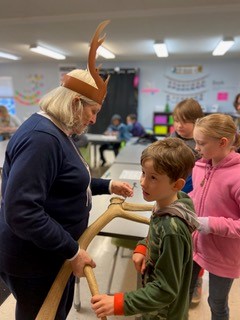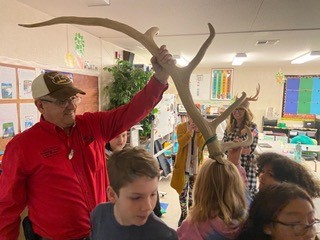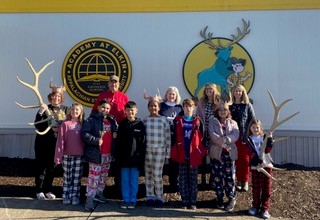My husband Ray and I share a love for elk. We helped found a local chapter of the Rocky Mountain Elk Foundation which we’ve been involved in for over two decades and participated in the Great Smoky Mountain elk reintroduction program. Now that we’ve both retired, we take great pride in sharing our experience with the reintroduction and continuing to support its success in Western North Carolina. For years, the mission statement and message Pass it On has been embedded in our hearts. Ray and I strive to do our part by reaching out often in classrooms across the schools of Western North Carolina’s mountains as well as lending our helping hands during our annual RMEF banquets.
On a recent Friday morning, we found ourselves in a room buzzing with the energy of a group of second, third and fourth graders who were gathered to learn about elk conservation and habitat. Appalachian State University’s Elementary Academy at Elkin, North Carolina, boasts Bucky the Bull as its mascot, so it was most appropriate to share the Great Smoky Mountain elk reintroduction program with these eager children. Asking questions and fielding answers brought even shy students into the forefront. No question was unanswered, every face was focused as we told the story of bringing elk back to Western North Carolina after a 150-year absence.
Balancing the story with pictures and our ‘teaching-trunk,’ we detailed how dedicated volunteers, guided by the professional leadership of national park biologist Kim Delozier, brought a dream to reality. We utilized our collection of RMEF calendars to showcase elk in vibrant color photographs. These amazing pictures allowed students a glimpse of bulls, cows and calves in different phases of life. Eager hands were trembling with excitement as students were encouraged to touch elk hides and lift massive antlers. The sheds were quite a hit, since many of them were taller than the students when held side by side, and this created lots of “My turn, my turn!” comments.

Using his cow call, Ray demonstrated the chirping sound of a female elk as the bewildered children listened. Then to their surprise, the call was answered by a resounding bull elk bugle. Giggles and excitement flooded the room as the students realized the bellowing was coming from a hidden cell phone. Another big hit was teaching the students the indigenous Shawnee and Cree word ‘Wapiti’—meaning white rump. Imagine the snickers coming from grade-schoolers when they heard us talking about “white rumps!”
Handing out RMEF stickers, elk logo tattoos and paper elk antler headbands served as a magic ending. Our day was made as we watched dozens of paper elk antlers parading down a school hallway. Questions and answers and new vocabulary were an important part of the day for the students, but the smiles and endless thank-yous were our treasured reminders of a time well spent.

One of our goals is to encourage students to seek out the elk during future family travels to Cataloochee, Maggie Valley or Cherokee. Our aim is for young people to pass on their excitement to their families through their tales of holding huge antlers and handling predator skulls. Ray and I were thrilled to be among such delightful students, and we hope that our programs inspire future conservationists.
Just as educational programs allow us to share our mission, our annual RMEF banquets present an opportunity for us to share stories of elk reintroduction and the impact of wildlife conservation.
My husband Ray and I are big believers in making sure that our annual event is geared for youth and children. The committee makes certain that even the youngest guests at our banquet will have items and events designed for fun.
Chapter volunteers have personally funded youth RMEF memberships and taken time during our annual banquet to showcase our involved youth. Each youth member is brought on stage to receive recognition, an official RMEF youth membership certificate and an RMEF hat. The real impact, however, goes far beyond the banquet as these children and youth become the future generations of RMEF supporters. Year after year, families return with children and grandchildren to our banquets. It’s incredibly rewarding to see so many children Passing On the heritage of the elk and learning that hunting is conservation.
As Ray and I like to say, “Never pass up an opportunity to Pass it On for elk and conservation.”
